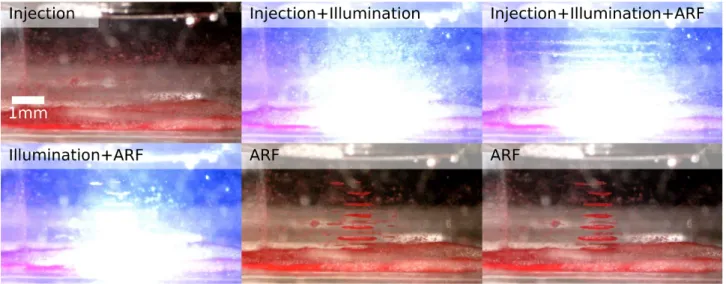HAL Id: hal-03095580
https://hal.archives-ouvertes.fr/hal-03095580
Submitted on 4 Jan 2021HAL is a multi-disciplinary open access archive for the deposit and dissemination of sci-entific research documents, whether they are pub-lished or not. The documents may come from teaching and research institutions in France or abroad, or from public or private research centers.
L’archive ouverte pluridisciplinaire HAL, est destinée au dépôt et à la diffusion de documents scientifiques de niveau recherche, publiés ou non, émanant des établissements d’enseignement et de recherche français ou étrangers, des laboratoires publics ou privés.
Cluster structuration of particle mixture in multi-node
acoustic levitation with optical exclusion
Nathan Jeger-Madiot, Mauricio Hoyos, Jean-Luc Aider
To cite this version:
Nathan Jeger-Madiot, Mauricio Hoyos, Jean-Luc Aider. Cluster structuration of particle mixture in multi-node acoustic levitation with optical exclusion. Acoustofluidics 2020, Aug 2020, Glasgow, United Kingdom. �hal-03095580�
Cluster structuration of particle mixture in multi-node acoustic
levitation with optical exclusion
Nathan Jeger-Madiot, Mauricio Hoyos and Jean-Luc Aider
11Laboratoire Physique et Mécanique des Milieux Hétérogènes (PMMH)
E-mail: nathan.jeger-madiot@espci.fr / mauricio.hoyos@espci.fr / jean-luc.aider@espci.fr Introduction
Acoustofluidic field is used for many applications as for the focusing[1], the separation [2] or the trapping[3] of particles or cells. These approaches are based on the control of the acoustic radiation forces (ARF)[4]. For a classical standing wave resonator, the acoustic force is generated by matching the height of the cavity ℎ with the acoustic frequency 𝑓!". If we want 𝑛 acoustic node trapping, we have to made a cavity with a height equal to 𝑛 𝜆 2⁄ . Recently, Dumy and al. [5] has observed a new phenomenon resulting from an acoustic and optical coupling. They show that after the particles are trapped and aggregated at the center of the acoustic node, the particles can be ejected by applying to them a specific optical wavelength. Hereby we propose a new approach to structure multi-clusters in multi-nodes acoustic levitation combining microfluidic channels, the acoustic radiation forces (ARF) and the specific optical illumination.
2D ejection with the optoacoustic phenomenon
In a multi-nodes standing wave cavity, the particles can be trapped in a central cluster. After a short transient period and using the proper parameters, the clusters become circular monolayers levitating in the surrounding fluid. The control of the flow, the ARF and the optical illumination allows various manipulations. For example, on the figure 1, it is possible to eject the particles from the monolayer successively from the first to the last aggregate of the acoustic levitation column.
Figure 1: Examples of the optical ejection of particles coupled with multi-node acoustic levitation. At the beginning the
particles are trapped in acoustic levitation, then the optical illumination ejects the particles from the center of aggregate. By turning off the illumination, the effect is reversible and the particles come back to their initial positions.
Multi-particle aggregation : toward 3D construction
This approach can be extended to shape clusters simultaneously with several particles. Indeed, the optical ejection only appears if the optical wavelength corresponds to the absorbance of the particle. To proof this concept we have used a binary mixture of two type of particles. The first one is red and have absorption at a wavelength equal to 𝜆 = 465𝑛𝑚 and the second one with white color, which is not sensitive to the previous wavelength. By injecting a suspension of the mixture with an active opto-acoustic effect, we can trap simultaneously on all the aggregates, the white particles at the center with all around the red particles. See Figure 2.
Conclusion
With our set of experiments, we show different ways to manipulate and structure mixture of particles. One of the advantages of such approaches are the use of both optical absorption and acoustic properties. It offers a large panel of setting for the manipulation of particles.
Figure 2: Example of multi-nodes structuration with a binary mixture. The mixture of particles is injected with a flowrate,
then the optical illumination and the acoustic forces are triggered. Afterwards, the flowrate is stopped. After ten seconds, the illumination is turned off. These results show a large cluster of white particles enclosed by a circular ring of red particles.
References
[1] G. Goddard, J. C. Martin, S. W. Graves, et G. Kaduchak, « Ultrasonic particle-concentration for sheathless focusing of particles for analysis in a flow cytometer », Cytometry A, vol. 69A, no 2, p. 66‑74, févr. 2006, doi:
10.1002/cyto.a.20205.
[2] M. Wu, A. Ozcelik, J. Rufo, Z. Wang, R. Fang, et T. Jun Huang, « Acoustofluidic separation of cells and particles », Microsyst. Nanoeng., vol. 5, no 1, p. 32, déc. 2019, doi: 10.1038/s41378-019-0064-3.
[3] M. Evander et J. Nilsson, « Acoustofluidics 20: Applications in acoustic trapping », Lab. Chip, vol. 12, no 22, p.
4667, 2012, doi: 10.1039/c2lc40999b.
[4] J. Friend et L. Y. Yeo, « Microscale acoustofluidics: Microfluidics driven via acoustics and ultrasonics », Rev.
Mod. Phys., vol. 83, no 2, p. 647‑704, juin 2011, doi: 10.1103/RevModPhys.83.647.
[5] G. Dumy, M. Hoyos, et J.-L. Aider, « Observation of selective optical manipulation of particles in acoustic levitation », J. Acoust. Soc. Am., vol. 146, no 6, p. 4557‑4568, déc. 2019, doi: 10.1121/1.5139640.

